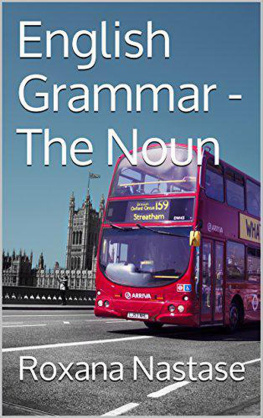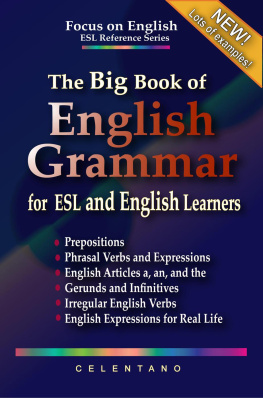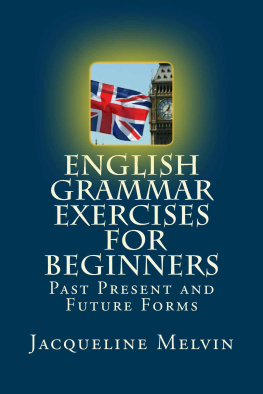ROXANA NASTASE
ENGLISH GRAMMAR PRACTICE EXPLANATIONS & EXERCISES WITH ANSWERS SCARLET LEAF 2017 SCARLET LEAF PUBLISHING HOUSE TORONTO ONTARIO CANADA COPYRIGHT BY ROXANA NASTASE
All rights reserved. No part of this book can be used or reproduced in any manner whatsoever without written permission, except in the case of brief quotations embodied in critical articles and reviews. For information address Scarlet Leaf Publishing House Scarletleafpublishinghouse@gmail.com
TABLE OF CONTENTS
SIMPLE PRESENT TENSE AND PRESENT CONTINUOUS
E XPLANATIONS A. Situations:
. TO EXPRESS A GENERALLY valid truth Ex: Earth goes round the Sun. 2.
To show that a certain present action develops repeatedly or frequently Ex: I often go with them to the sea. Note : Generally, an adverb or an adverbial phrase is present in the sentence in such a situation: always, often, rarely, every day, twice a month etc. Exception : if we want to express irritation, annoyance or a negative emotion, then, although the action presents a certain frequency, the verb is in present continuous to emphasize the respective affirmation. Ex: You are always breaking something while washing up! 3. There are certain verbs used only in Simple Present Tense to know to own to seem to want to understand to agree to love to smell to mean to hate to see to wish to belong to like to hear to believe to hope to need to sound to have to realise to appear to taste to recognize Exceptions: TO HAVE - when it is used in phrases, it changes its meaning and therefore, may be used in Simple or Continuous Present Tense, up to the situation Ex1: I have dinner at six o'clock in the evening. (action taking place only this evening) TO SMELL - when it is followed by a direct object may be used in Simple Present Tense or Continuous Tense up to the situation. (action taking place only this evening) TO SMELL - when it is followed by a direct object may be used in Simple Present Tense or Continuous Tense up to the situation.
Ex1: He is smelling a rose. Ex2: He smells the roses in the garden every day. TO SEE - when its meaning is TO MEET may be used in Simple Present Tense or Continuous Tense up to the situation. Ex. 1: She sees him every day. 2: She is seeing him at three oclock today. (Present Continuous, temporary action) when it is used in forming expressions - it changes meaning Ex.: to see off may be used in Simple Present Tense or in Continuous Tense up to the situation. (Present Continuous, temporary action) when it is used in forming expressions - it changes meaning Ex.: to see off may be used in Simple Present Tense or in Continuous Tense up to the situation.
TO TASTE - in situations like: a) To show that something is tasteful then, we use Simple Present Tense Ex.: This soup tastes great! b) To show that someone wants to see if there is necessary to put something into a dish or to let it as it is, then, we can use the verb either in Simple Present Tense or in Present Continuous, depending on the situation. Ex.1: I always taste the soup to see if it is salty enough. Ex.2: What are you doing? Im tasting the soup. TO HEAR - in situations like: a) To show the perception of hearing Simple Present Tense Ex.1: Whats that? I hear a noise. b) To show a situation similar to listening: Simple Present Tense if we have a truth or a frequency Ex.: Judges hear people during trials. Present Continuous if we have a temporary situation Ex.: Whats the judge doing? - The judge is hearing the witness now.
TO HATE / TO LOVE used in Present Continuous Tense only to show a temporary action Ex.: Im hating this book! to think 1. to believe (showing opinion) Simple Present Tense Ex: I think youre right. 2. actual action of thinking Simple Present Tense / Present Continuous Tense Ex. 1: I always think of you, you know that. 2: Im thinking of you right now. to expect 1. related to expectations Ex.: I expect it will clear up. 2. when you wait for someone or something Ex.: Im expecting some friends TO BE may be used in Present Continuous Tense only when we want to emphasize the negative behaviour of someone in a certain moment. when you wait for someone or something Ex.: Im expecting some friends TO BE may be used in Present Continuous Tense only when we want to emphasize the negative behaviour of someone in a certain moment.
Note the difference: Ex.1: He is a very naughty boy. ( general feature ) Ex.2: He is being very naughty today. ( temporary situation ) 4. When the verbs express a non-durative action, the verb is used in Simple Present Tense. Ex.: The boy suddenly jumps in the middle of the room. 5.
When we express habits or features: Ex1: They have dinner at seven oclock in the evening. (habit) Ex2: They are having dinner at seven oclock this evening. (temporary action) 6. Simple Present Tense is used to present a demonstration, to comment a match, to give instructions Ex: The boy takes the ball and passes it to his colleague. This one runs to the other side of the field and scores. 7.
The Simple Present Tense is also used to tell a story in present even if the action took place in the past or to make a statement. Ex: I bet you read a novel and you dont learn.
. WE USE SIMPLE PRESENT Tense for: titles for articles in newspapers and magazine Ex: Factory blows up in the north. instructions; itineraries Ex: You take the flour and the butter and rub them together. in scenarios for instructions Ex: The actor gets onto the stage on the right side of the stage. in scenarios for instructions Ex: The actor gets onto the stage on the right side of the stage.
He walks to the middle of the stage. 9. We may use a verb in Simple Present Tense to express a future, when the action is formally planned or to refer to timetables for trains, planes, buses and so on. Ex: The conference starts at ten o'clock tomorrow. 10. Present Simple Tense shows the simultaneity of the action in a clause sentence with the action in the main sentence whose verb is in the future.
Next page












